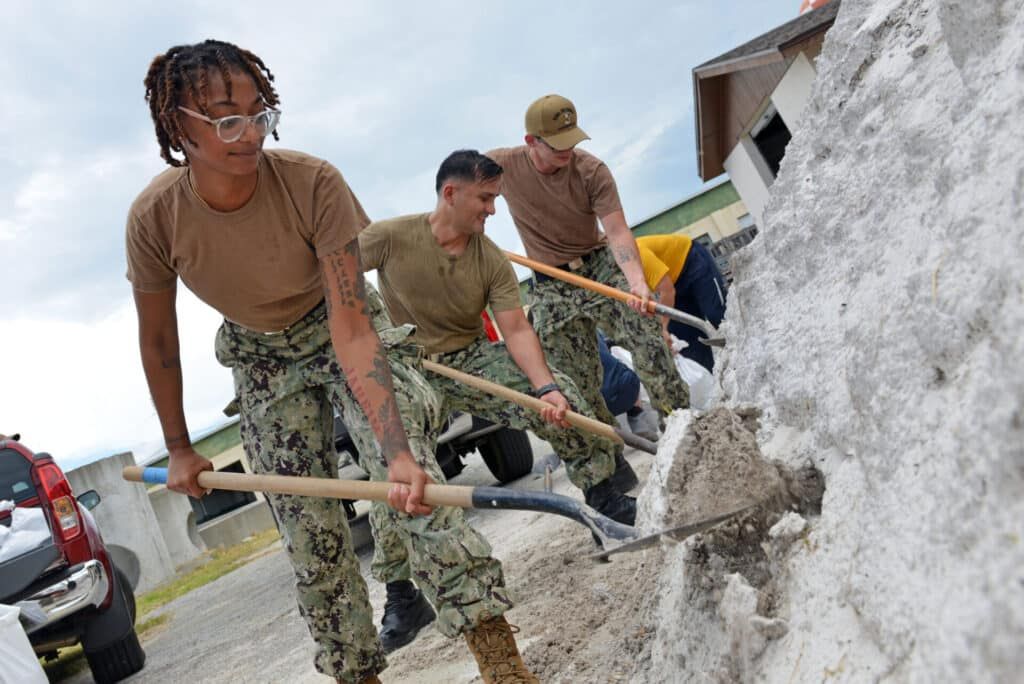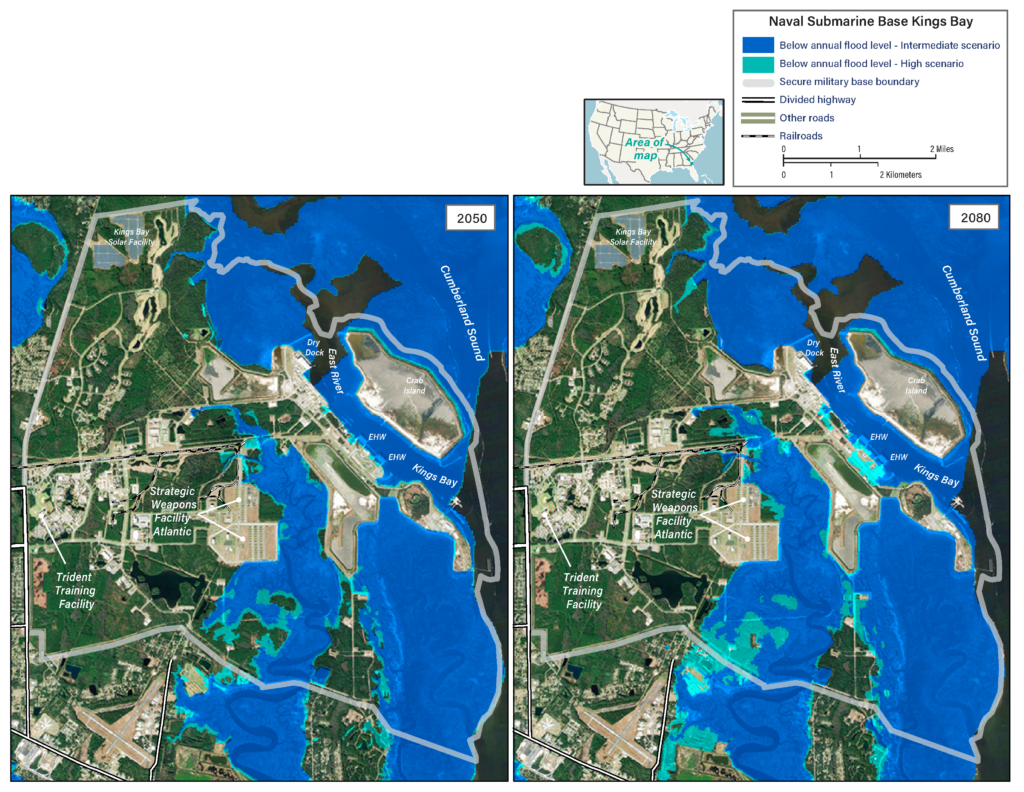Kings Bay nuclear submarine hub dodged a bullet named Hurricane Idalia
By Jamie Kwong | September 15, 2023
 US Navy southeastern bases prepare for the arrival of Tropical Storm Idalia on August 28, 2023. At Naval Submarine Base Kings Bay in Georgia, four Ohio-class ballistic-missile submarines ongoing maintenance and two support ships were secured to the pier with heavy weather moorings ahead of high winds. (Image: US Navy / Jacob Sippel)
US Navy southeastern bases prepare for the arrival of Tropical Storm Idalia on August 28, 2023. At Naval Submarine Base Kings Bay in Georgia, four Ohio-class ballistic-missile submarines ongoing maintenance and two support ships were secured to the pier with heavy weather moorings ahead of high winds. (Image: US Navy / Jacob Sippel)
Last month, Hurricane Idalia slammed parts of Florida, Georgia, and the Carolinas. It also threatened to devastate one of only two US bases that host nuclear-powered ballistic missile submarines.
Located in Camden County, Georgia—just north of the Florida border—Naval Submarine Base Kings Bay is the Atlantic hub of the US nuclear submarine fleet. It’s tasked with maintaining and servicing these billion dollar systems and their nuclear missiles, which the United States relies on to assure its capacity to launch a nuclear strike “anywhere, anytime.”
Hurricane Idalia put this key nuclear mission at risk.
Idalia’s wrath. As the storm barreled near, state and local authorities did their best to prepare, declaring states of emergency and issuing evacuation orders. They weren’t alone. Military bases along the southeastern coastline battened down the hatches, preparing their facilities, systems, and personnel for the worst.
This isn’t the first time the military has dealt with powerful storms and their devastating aftermath. Take Tyndall Air Force Base in Florida, where a Category 5 hurricane caused catastrophic damage in 2018. At a cost of $5 billion, the base is still rebuilding, making significant efforts to ensure it’s resilient to the most powerful storms.
In anticipation of Idalia, Kings Bay operations and personnel were seriously curtailed. Four nuclear submarines undergoing maintenance had to be tightly tethered with heavy weather moorings. Base movements were strictly limited. On-base facilities, including the nursery, health clinic, and commissary, were closed. And civilian employees and dependents were ordered to evacuate according to local authorities’ guidance.
While Idalia’s eventual downgrade from a Category 4 hurricane to a tropical storm meant the worst devastation was avoided, the storm—and flooding and storm surge left in its wake—still wreaked havoc. Homes and business were destroyed, hundreds of thousands were affected by power outages, schools closed, the list goes on.
Kings Bay seems to have dodged the worst. Reports indicate the installation experienced minimal damage and resumed normal operations the morning after the storm passed.
But the base may not be so lucky next time. Hurricanes are only expected to get worse as global temperatures rise. A warmer ocean and atmosphere fuel the evaporation-condensation cycle that powers hurricanes, causing more rain, stronger winds, and so, more powerful storms. Idalia’s rapid intensification amid unseasonably warm ocean temperatures in the Gulf suggest this phenomenon may well already be underway.
The direct impacts of, say, Category 4 hurricane winds of up to 156 miles (251 kilometers) per hour would be devastating enough for Kings Bay. Add in storm surge—which, paired with sea level rise, is going to expose more of the base to deeper flooding as the century progresses—and it’s not difficult to envision that the collective impacts of a hurricane could severely undermine the base’s capacity to function—and deliver its nuclear mission.
Weathering more than hurricanes. Although climate science can tell us that warming will make hurricanes more severe, it is exceedingly difficult to project whether these extreme weather events will be more frequent.
Sea level rise and annual flooding, on the other hand, can be reasonably projected into the future. And these climate change effects alone could significantly affect Kings Bay’s capacity to service and maintain the nuclear submarines based there. Over the next few decades, various climate change scenarios project that rising waters will inundate not just waterfront facilities, but also a key road connecting the on-base nuclear missile facility to the waterfront (see Figure 1). These climate effects therefore may not only disrupt base operations and submarine servicing—as did Idalia—but they could also potentially delay the transport and maintenance of the submarines’ nuclear missiles, with serious implications for the readiness of the SSBN fleet.
The Navy stares down this new reality as it prepares to deploy the modernized Columbia-class submarine to Kings Bay. These submarines will replace the current Ohio-class fleet starting in the 2030s and are expected to be in service until the 2070-80s. The new submarines are part of a larger effort to modernize the entire US nuclear arsenal to ensure it can protect the United States and its allies for decades to come, a multi-billion—if not -trillion—dollar investment.
Climate change stands to challenge these modernized systems and their deterrence mission. And these challenges aren’t isolated to systems hosted at coastal nuclear facilities like Kings Bay. Warming temperatures could accelerate extreme flooding that may limit access to intercontinental ballistic missile (ICBM) silos and facilities at Minot Air Force Base in North Dakota. This problem of accessibility, in turn, could reduce the reliability of some ICBMs by delaying critical maintenance or deliveries. Meanwhile, extreme heat and flash flooding could affect the times and conditions when stealth nuclear bombers can take off from or land at Whiteman Air Force Base in Missouri, which could have implications for the readiness of the larger bomber fleet.
Kings Bay’s near miss with Hurricane Idalia illustrates the range of new challenges and threats climate change poses to the entire US nuclear arsenal. As these challenges risk detrimental impacts to the “backbone of America’s national security,” the military will have to prepare its critical—and limited—nuclear weapons facilities to weather more than just hurricanes.
Together, we make the world safer.
The Bulletin elevates expert voices above the noise. But as an independent nonprofit organization, our operations depend on the support of readers like you. Help us continue to deliver quality journalism that holds leaders accountable. Your support of our work at any level is important. In return, we promise our coverage will be understandable, influential, vigilant, solution-oriented, and fair-minded. Together we can make a difference.
















As someone who works at the location mentioned in the article, there’s a lot of fear mongering here. This was almost fully written looking in at operations with no context or understanding of capabilities and operational expectations.
I agree. I helped develop the equipment supply plan for base recovery for N13/LMR after Andrew. We learned a bunch after an ice storm in 1992 too! This climate change narrative is BS. Hurricane activity is cyclical. Just like sunspots, tides, and normal deviations of earth heating and cooling. This planet wobbles on its axis! Yes, it affects the planet’s weather! Much of this is absolutely unrelated to any human activity or control. Any of us who have sailed should understand the sea is her own, we are at her mercy, despite all preparation, skill, or planning. This whole boondoggle… Read more »
Never put all of your eggs in one basket. One of the biggest mistakes we made was consolidating all of our Navy Bases that housed SSBN commands. I am an ex sub sailor and never agreed to or saw the logic in consolidation of our strategic assets. If a storm can take us out what do you think the Chinese or Russians could do.
Too bad we walked away from Subic Bay and Clark Air Force Base! Does anyone remember/recall this stupidity?
You are confused. We dodged a radioactive bullet named nuclear sub hub.
Are not up to 2/3rd of nuclear sub fleet at sea at any one time so not to be vulnerable to attack on the base?
It depends on whether you are referring to boomers or attack subs. And if we had to refit in Britain, we could
Our next sub hub will be Australia, and the Phillipines might be ready to invite the US Navy baaaaack! Kings Bay and Bremerton, may be our Trident facilities but we have refit and repair capabilities around the world, with ports and assistance available through British and French programs, as well.